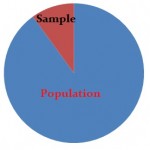Statistics Definitions > What is a Population in Statistics?
What is a Population in Statistics?
A population is every member of a group. It is is the opposite of a sample, which is a fraction or percentage of a group. Sometimes it’s possible to survey every member of a group. A classic example of a population is the U.S. Census, where it’s the law that every member of the U.S. population has to respond. In most cases in statistics, it’s impractical to survey everyone.
Imagine how long it would take you to call every dog owner in the U.S. to find out what their preferred brand of dog food was. In addition, sometimes people either don’t want to respond or forget to respond, leading to incomplete censuses. Incomplete censuses become samples by definition.
Note: if you do manage to survey everyone, it actually is called a census: The U.S. Census is just one example.
Need help with a homework question? Check out our tutoring page!
Sample vs. Population Example

If you go into a candy store, the owner might have samples of their products on display. It wouldn’t be possible for you to sample everything in the store; Financially the owner wouldn’t want you to taste everything for free. And you probably wouldn’t want to eat a sample of candy from a couple hundred jars or you might get sick to your stomach. So, you might base your opinion about the entire store’s candy line based on the samples they have to offer. The same logic holds true for most surveys in stats; You’re only going to want to take a sample of the whole population (“population” in this example would be the entire candy line). The result is a statistic about that population.
Statistic vs. Parameter.
A parameter is data about an entire population. For example, if you want to find out which classes freshmen at a certain college were taking, you could ask everyone (perhaps via email) and it would be possible to get a parameter. Statistics are when you base your data from samples. For example, you might ask 20 percent of the freshman class what classes they are taking and use that data to make assumptions about what everyone is taking.
If you base your results from a bit of the population, your results aren’t going to be perfect. That’s where we talk about margins of error and confidence intervals in stats. In the candy store, you might be able to get a good feel for the candy line if you taste a few samples, but how confident are you that you can accurately say if your sampling wasn’t skewed? Perhaps the candy that day was extra fresh and tasted wonderful, or perhaps the flavors offered were ones that you didn’t care for. If you had the opportunity to taste test everything, you could offer an excellent opinion about the parameters of the candy line, but with sampling, all you have is a statistic.
References
Gonick, L. (1993). The Cartoon Guide to Statistics. HarperPerennial.
Lindstrom, D. (2010). Schaum’s Easy Outline of Statistics, Second Edition (Schaum’s Easy Outlines) 2nd Edition. McGraw-Hill Education